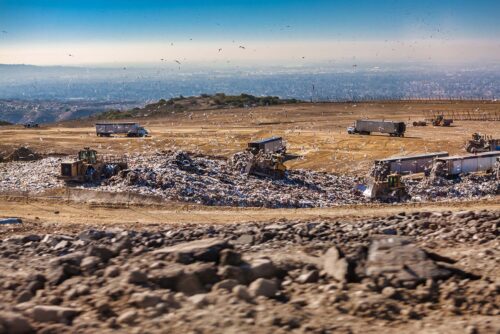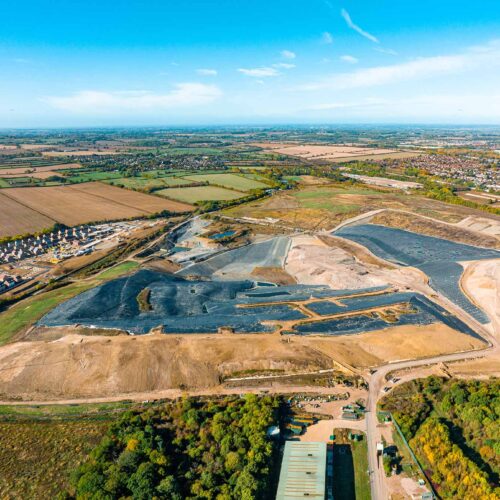
Waste Methane 101: Driving Emissions Reductions from Landfills
Landfills generate methane as organic waste decomposes. Here's how we can mitigate and prevent these climate-warming emissions.
Municipal solid waste landfills are the third largest source of human-related methane emissions in the United States. Our municipal landfills emit an estimated 3.7 million metric tons of methane, or about 295 million metric tons of carbon dioxide equivalent (MMT CO2 e) on a 20-year time horizon. This is roughly equivalent to the annual emissions from driving 66 million gas-powered passenger cars or operating 79 coal-fired power plants. Furthermore, recent aircraft and satellite surveys have detected large methane plumes at landfills across the country with substantial under-reporting at some landfills.
Fortunately, there are proven strategies to better control methane emissions at the landfill while keeping methane-generating organic waste out of the landfill in the first place. In this article, we discuss mitigation and prevention strategies, change levers, and the benefits of acting now to curb landfill methane.
The Problem with Landfills: What Goes In & What Comes Out
Each year, more than 145 million tons of waste are landfilled across the United States. More than half of this waste is organic, or biodegradable, and food waste is the single most common landfilled material. As organic waste decomposes at the landfill, it generates methane: a super-potent greenhouse gas with about 80 times the warming power of carbon dioxide on a 20-year time horizon. While some landfills are required to control their gas, the amount of methane actually captured can vary widely based on design and operational practices.
The figure below shows the key drivers of landfill methane, from the incoming organic waste that generates the methane to the shortcomings in control systems that allow it to escape. Landfills emit methane diffusely through the landfill surface (area source emissions) and in more concentrated hot spots (point source emissions), which can arise from cracks in the landfill cover, a poorly operating gas collection system, or inefficient flares, among other causes. Operators typically conduct surface methane monitoring once every three months, which means leaks can go undetected.
Beyond methane, landfills emit hazardous air pollutants, precursors to ozone and particulate matter, odor nuisance compounds, and other dangerous gases that can impact air quality, human health, and quality of life. Landfill-adjacent communities bear the brunt of these impacts. According to the EPA’s EJScreen, 54 percent of reporting landfills have communities within one mile that exceed the national average for percent people of color or percent low-income.
How We Fix It: Control Methane, Divert Organics!
While 145 million tons is a huge number, the waste landfilled in any one year is small compared with all the methane-generating waste already sitting in landfills today. Addressing landfill methane, therefore, will require a two-pronged approach: (1) improved monitoring and controls to mitigate emissions from waste in place, and (2) reduced organic waste disposal to prevent future methane generation.
Mitigating Emissions from Waste in Place
Improvements in design and operations can help control methane emissions at the landfill. These include: comprehensive monitoring to quickly detect and repair fugitive emissions, effective cover practices to control surface methane, robust gas collection system design and operations to maximize gas capture, and efficient destruction or beneficial use of collected landfill gas. The figure below depicts a well-designed and managed landfill that maximizes gas collection while minimizing fugitive emissions.
The California Air Resources Board estimates that a direct emission reduction of 10 percent is achievable across the state’s landfills by 2030 through increased monitoring, operational improvements, lower permeability covers, and advanced landfill gas collection systems. Maryland’s Department of Environment estimates a 25–50 percent reduction in landfill gas emissions from its landfill gas monitoring and control regulation when fully implemented.
Preventing Future Methane Generation
Reducing organic waste disposal in landfills prevents new methane generation. This strategy includes upstream efforts to reduce and redistribute surplus, and downstream efforts to recycle the remaining organic waste. Minimizing food waste on farms, improving inventory management, and donating excess edible food all help to keep organics out of our waste stream. The remaining organic waste can then be separated and processed into compost, biogas, or other beneficial end products.
Composting facilities avoid methane generation by breaking down organic waste aerobically (with oxygen), while anaerobic digesters generate methane in an enclosed tank that limits fugitive methane emissions. Diverting 75 percent of US food waste landfilled in one year to a composting facility or anaerobic digester would drive an 80–90 percent emissions reduction over the waste’s lifetime compared to landfilling, per EPA’s Waste Reduction Model (WARM). The figure below depicts various alternatives to landfilling organic waste. The result is a more circular, efficient, and low-emission waste management system.
Based on Figure 4-1 from EPA’s Downstream Management of Organic Waste in the United States: Strategies for Methane Mitigation
Levers to Drive Change
There are multiple levers to execute on the strategy outlined above, from policy to industry to changes in our own kitchens.
On the federal level, the EPA regulates landfills under the Clean Air Act and has broad authority to set design and work practice standards that deliver emissions reductions. The agency is required to revisit its landfill rules in 2024 and should develop ambitious standards that reflect the latest best practices in methane control while encouraging organics diversion. Congress can also provide funding for subnational efforts to reduce food loss and waste and expand organics recycling infrastructure, including through the Farm Bill.
At the state level, strong landfill standards, methane monitoring programs, organics diversion ordinances, edible food donation requirements, and compost procurement programs can drive emissions reductions. Local governments are also critical decision makers in waste management, overseeing collection and disposal services for residents. Many landfills in the United States are owned by municipalities who can implement best practices to monitor and control their methane. Cities also have jurisdiction to set their own organics diversion targets and improve and expand local organics collection and recycling infrastructure.
Government aside, operators can take steps to drive methane reductions. Comprehensive controls can carry incremental costs for landfill operators, but they can also generate savings over time. Improving gas capture rates increases revenue for landfills selling their gas, and there are funding opportunities to support methane monitoring and abatement. Similarly, organics recycling projects can have higher upfront costs than landfilling, but the revenue from valorized end products (e.g., compost, biogas, digestate) can make projects economically viable, and in some cases more profitable, than landfilling over time. Plus, there are tax credits and funding opportunities that project developers can take advantage of in the Inflation Reduction Act.
Finally, every pound of organic waste households keep out of the landfill is a pound that won’t go on to generate methane. There are a number of strategies to reduce personal food waste, from better meal planning and food storage to home composting.
The Benefits of Acting Now
Methane mitigation and prevention can deliver cross-cutting benefits, including:
Slow Near-Term Warming: Methane mitigation can rapidly reduce the rate of warming in the near term. Strong, rapid, and sustained methane reductions across sectors are key to slow near-term warming and limit the risk of climate tipping points.
Meeting Our Climate Commitments: The United States set several targets to reduce methane emissions as a signatory of the Global Methane Pledge (GMP) and at the 2023 North American Leaders’ Summit. Decisive action to control landfill emissions would help the United States meet its methane-specific and broader climate commitments; GMP-aligned methane reductions would contribute an estimated 8 percent to the 50–52 percent overall emissions reductions the United States committed to at COP26.
Protecting Landfill-Adjacent Communities: Many of the technologies and practices that reduce landfill methane emissions also reduce emissions of volatile organic compounds, odors, and other local air pollutants, per EPA. Stronger standards to capture and control landfill gas can therefore help address the air quality and odor issues facing landfill-adjacent communities. Strategies to prevent and divert organic waste also help reduce odors, minimize leachate generation and associated groundwater pollution, and prevent landfill expansion.
Delivering Local Benefits: Food waste prevention saves households money, while donation puts food on the table for families in need. Organics recycling can also create jobs, as composting facilities typically employ more people per ton of waste than landfills do. The end products of organic recycling carry additional benefits: biogas from diverted organics can be used to displace local fossil demand, and compost can improve soil health, sequester carbon, promote higher crop yields, and aid in reforestation and wetlands restoration.

